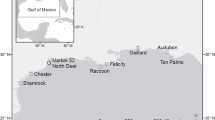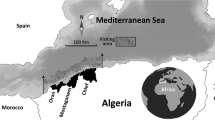Abstract
Selenium, copper, cadmium, and zinc concentrations were measured in mullet (Mugil cephalus) from the southern basin of Lake Macquarie, Australia, in 1997 to determine if improved ash-handling practices at an adjacent coal fired power station, implemented in 1995, had significantly lowered trace metal concentrations in mullet tissues. Mean muscle tissue concentrations of selenium (5.9 ± 0.7 μg/g dry mass), copper (3.6 ± 0.1 μg/g dry mass), and zinc (14 ± 1 μg/g dry mass) are lower than previously reported for mullet analyzed in 1993 (10 ± 2, 21 ± 3, 27 ± 3 μg/g dry mass, respectively). Cadmium concentrations in liver tissues increased from 2.3 ± 0.3 to 6 ± 2 μg/g dry mass. Significant intra-tissue correlations between metal concentrations were found for all tissues except muscle. Strong correlations of selenium, copper, and zinc concentrations were found in liver tissues, indicating a common primary source may exist for these metals, such as fly ash. All trace metals were found to have significant inter-tissue correlations, with strong correlations occurring for selenium between all tissues and for cadmium between all tissues except muscle. Regulation of copper, cadmium, and zinc appears to be occurring in muscle tissue. Selenium concentrations in mullet are still above levels considered to be of concern to human consumers. Trace metal concentrations are below that known to effect the health of fish. Mullet are directly exposed to trace metal concentrations as a result of feeding and the ingestion of contaminated sediment and detritus. Lower metal concentrations found in mullet tissues are attributed to the burial of highly contaminated sediment with material containing lower trace metal concentrations. Little of the variations in trace metal concentrations between mullet was explained by mass, gender, or age.
Similar content being viewed by others
Author information
Authors and Affiliations
Additional information
Received: 20 August 2000/Accepted: 22 February 2001
Rights and permissions
About this article
Cite this article
Kirby, J., Maher, W. & Harasti, D. Changes in Selenium, Copper, Cadmium, and Zinc Concentrations in Mullet (Mugil cephalus) from the Southern Basin of Lake Macquarie, Australia, in Response to Alteration of Coal-Fired Power Station Fly Ash Handling Procedures. Arch. Environ. Contam. Toxicol. 41, 171–181 (2001). https://doi.org/10.1007/s002440010235
Issue Date:
DOI: https://doi.org/10.1007/s002440010235




